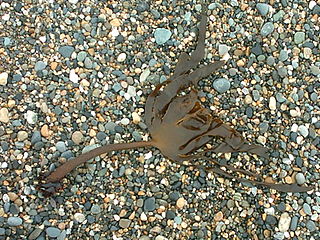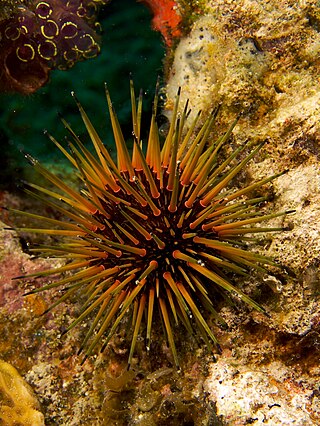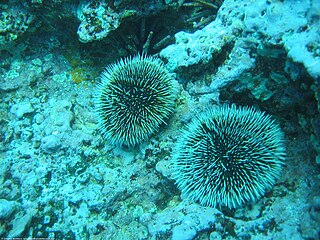
Sea urchins or urchins are typically spiny, globular animals, echinoderms in the class Echinoidea. About 950 species live on the seabed, inhabiting all oceans and depth zones from the intertidal to 5,000 metres. Their tests are round and spiny, typically from 3 to 10 cm across. Sea urchins move slowly, crawling with their tube feet, and sometimes pushing themselves with their spines. They feed primarily on algae but also eat slow-moving or sessile animals. Their predators include sea otters, starfish, wolf eels, and triggerfish.

Kina is a sea urchin endemic to New Zealand. This echinoderm belongs to the family Echinometridae and it can reach a maximum diameter of 16–17 cm.

Echinus esculentus, the European edible sea urchin or common sea urchin, is a species of marine invertebrate in the Echinidae family. It is found in coastal areas of western Europe down to a depth of 1,200 m (3,900 ft). It is considered "Near threatened" in the IUCN Red List of Threatened Species.

Loxechinus albus is an echinoderm of the family Parechinidae, native to coastal southern South America, ranging from Ecuador, along the entire coasts of Peru and Chile, to Argentina, as well as the Falkland Islands. It is the only species in the genus Loxechinus. It is known as the Chilean sea urchin or red sea urchin, but the latter name is typically used for the North Pacific Mesocentrotus franciscanus and it is not the only species of sea urchin in Chile. L. albus is found on rocky reefs and shores in the intertidal and subtidal zones to a depth of 340 m (1,120 ft).

Culcita schmideliana, commonly known as the spiny cushion star, is a species of pin-cushion star. It has a variety of base colors and often patches of a different color. It is pentagonal in shape and lives in the tropical Indo-Pacific. This species is rarely kept by hobby aquarists.

Strongylocentrotus droebachiensis is commonly known as the green sea urchin because of its characteristic green color, not to be confused with Psammechinus miliaris as it is also commonly called the green sea urchin. It is commonly found in northern waters all around the world including both the Pacific and Atlantic Oceans to a northerly latitude of 81 degrees and as far south as Maine and England. The average adult size is around 50 mm (2 in), but it has been recorded at a diameter of 87 mm (3.4 in). The green sea urchin prefers to eat seaweeds but will eat other organisms. They are eaten by a variety of predators, including sea stars, crabs, large fish, mammals, birds, and humans. The species name "droebachiensis" is derived from the name of the town Drøbak in Norway.

Echinus is a genus of sea urchins. Sea urchins are echinoderms that are typically spherical or flattened with a covering of spine-like structures. Sea urchins tend to be important members of their ecosystems by grazing on other organisms and stabilizing populations. In addition to this, sea urchins play a large role in different economies globally as the urchin themselves and their roe are sold for consumption. The same is true for the species within the genus Echinus.

Ecklonia cava, also called paddle weed, kajime, noro-kajime, or gamtae (Korean: 감태), is an edible marine brown alga species found in the ocean off Japan and Korea.

Spinochrome B (2,3,5,7-tetrahydroxynaphthoquinone) is an organic compound with formula C
10H
6O
4, formally derived from 1,4-naphthoquinone through the replacement of four hydrogen atoms by hydroxyl (OH) groups.

Toxopneustes pileolus, commonly known as the flower urchin, is a widespread and commonly encountered species of sea urchin from the Indo-West Pacific. It is considered highly dangerous, as it is capable of delivering extremely painful and medically significant stings when touched. It inhabits coral reefs, seagrass beds, and rocky or sandy environments at depths of up to 90 m (295 ft). It feeds on algae, bryozoans, and organic detritus.

Paracentrotus lividus is a species of sea urchin in the family Parechinidae commonly known as the purple sea urchin. It is the type species of the genus and occurs in the Mediterranean Sea and eastern Atlantic Ocean.

Psammechinus miliaris is a species of sea urchin in the family Parechinidae. It is sometimes known as the green sea urchin or shore sea urchin. It is found in shallow areas of the eastern Atlantic Ocean and the North Sea.
Aspidodiadema jacobyi is a small sea urchin in the family Aspidodiadematidae. It lives in tropical seas at great depths. Aspidodiadema jacobyi was first scientifically described in 1880 by Alexander Emanuel Agassiz, an American scientist.

Echinometra viridis, the reef urchin, is a species of sea urchin in the family Echinometridae. It is found on reefs in very shallow parts of the western Atlantic Ocean and the Caribbean Sea.

Tripneustes depressus, the white sea urchin or sea egg, is a species of sea urchin in the family Toxopneustidae. It is found on the seabed in the tropical eastern Pacific Ocean including Mexico, Panama, Ecuador and the Galápagos Islands.

Toxopneustes roseus is a species of sea urchin from the East Pacific. It is sometimes known as the rose flower urchin or the pink flower urchin. Like the related flower urchin, they are venomous.

Gracilechinus acutus is a species of sea urchin in the family Echinidae, commonly known as the white sea urchin. It is an omnivore and feeds on algae and small invertebrates.
Acrosorium polyneurum is a species of red algae first described by Okamura. It grows in intertidal and shallow subtidal waters in Japan where it is grazed by the sea urchin Hemicentrotus pulcherrimus.

Pseudocentrotus depressus, commonly known as the pink sea urchin, is a species of sea urchin, one of only two species in the genus Pseudocentrotus. It was first described in 1864 by the American marine zoologist Alexander Agassiz as Toxocidaris depressus, having been collected during the North Pacific Exploring and Surveying Expedition undertaken by Captain Cadwalader Ringgold and later Captain John Rodgers.

Tetrapygus is a genus of sea urchins in the family Arbaciidae. It is a monotypic genus and the only species is Tetrapygus niger which was first described by the Chilean naturalist Juan Ignacio Molina in 1782. It is found in the southeastern Pacific Ocean on the coasts of South America.

















